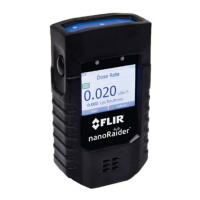D. Glossary FLIR Detection
Figure 242. Full width at half maximum height of a peak
Fusion
An exothermic nuclear process in which two or more light ÚNuclei are conined together
forming a heavier nucleus. The magnetic coninement is usually realized in plasma devices
as e.g. a Tokamak or a Stellarator. A Tokamak is a toroidal chamber surrounded by magnetic
coils. It can be seen as a huge current transformator, which produces enough potential to
ignite a plasma inside the chamber. Contrary to the symmetric appearance of a Tokamak, a
Stellarator has a non-symmetric, highly complex ield and chamber design.
Also known as: Nuclear Fusion
FWHM
ÚFull Width at Half Maximum
𝛾
Radiation
ÚGamma Radiation
Gamma Radiation
Gamma (𝛾) radiation is energetic (typically >100 keV) ÚElectromagnetic Radiation of high
frequency (typically >10
Hz) and very short wavelength (typically <10
m).
Gamma radiation originating from ÚDecay typically carries energies from a few hundred keV
to about 10 MeV and is ÚIonizing Radiation.
Gamma radiation penetrates deeply and is dificult to stop. It can be stopped by a suficiently
thick layer of material with high ÚAtomic Number, such as
82
Pb (lead, Figure 245, p. 283).
Also known as: 𝛾 Radiation
Gamma Ray Detection
Gamma rays can be detected by observing their interaction with matter. Some materials emit
visible light when hit by gamma rays (ÚScintillator), some gases are ionized and conduct
electricity (ÚGeiger–Müller Tube), or some semiconductors (ÚSemiconductor Radiation
Detector) change electric conductivity when exposed to gamma radiation.
Ge ÚGermanium
274 identiFINDER
®
R300/en/2014.4(13623)/Feb2015

